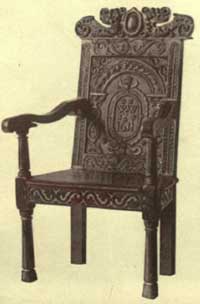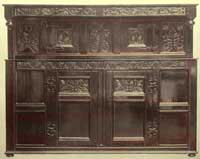Jacobean Furniture
The Jacobean furniture term defines the works belonging to the period between 1603 -1649. In its earlier stages, Jacobean furniture still displays the heavy enrichment of the Elizabethan carved oak furniture.
With the arrival of the Renaissance, the Gothic ornamentation derived from the pointed arch disappeared, and, after the close of the 16th century, no more Gothic details could be identified, except occasional “linen-fold” panels.
During the reign of James I., the furniture and the home decoration are still similar to those of the Tudor period. However, the influence of the Low Countries styles, and the contributions of Inigo Jones will gradually modify the Tudor mixture of Gothic and Renaissance.
The Jacobean period furniture was mainly made of oak. Lime and cherry were also used, while cypress was preferred for making chests.

Jacobean Chair
The furniture of the Jacobean era was massive, and the early Jacobean carving can be recognised by its simplicity. The carving was sometimes gilded, and, more often, the wood was painted. Some exotic woods were used for cabinet construction, and pear wood stained black and imitating ebony was also used in decorations.
The main characteristic of the Jacobean style was the severe perpendicularity of the furniture. The chairs had rectangular seats with their backs straight, their legs and those of tables were perpendicular.
The Jacobean furniture is noted by its decorative carving, with patterns of eights, contiguous circles, semicircles with petals within, lozenge panelling, double scrolls and the rounded arch. The spiral is used on chair-legs and cupboards.
Chairs were still an item meant for the use of the households' masters, thus they were not in great numbers. The characteristic Jacobean chair was the wainscot chair, of choir stalls inspiration. As opposed to the Elizabethan period, the top rail caps the back as part of the cresting. The wainscot chair became gradually lighter in form, while turned legs chairs appeared. An interesting, rare type of chair was the X shaped, upholstered chair. The upholstered chairs were brought from Venice during the reign of James I. A lighter French chair, with leather and embroidery covering the seat and the back, was introduced during the reign of Charles I.
The typical Jacobean table was of oak, similar to the Elizabethan period furniture. The legs were initially bulb-turned, evolving later to simpler baluster forms, with the rails carved in arabesque or lunette patterns.
Other interesting pieces of the Jacobean period were the richly carved chests and cupboards. The Jacobean beds were still similar to the Tudor period, and the massive Elizabethan "four-posted" bed was still hold in high esteem.
The Jacobean furniture tables had their width increased, and the top area could be doubled by drawing out two flaps from either end. The "folding table" of this period was made with twelve, sixteen, or twenty legs, and would fold into about one third of its extended size. Black lines of stained pear tree, let into the oak, were used to decorate the table top, while frequently the table legs were decorated with the carved bulb or acorn of Dutch design.
The carved bulb became a common feature of the Jacobean furniture, and was also applied to the supports of cabinets, either plainly turned, or carved.

